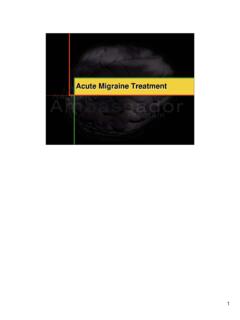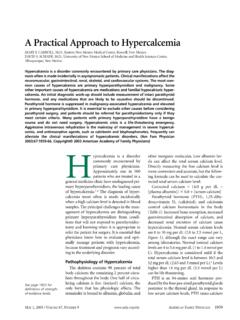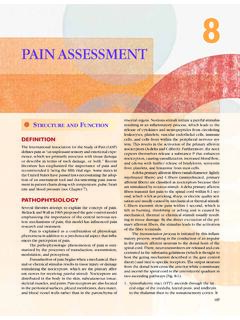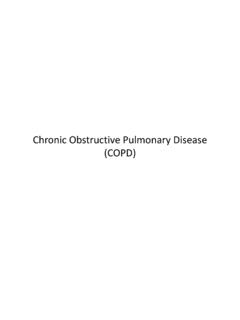Transcription of Pathophysiology of Migraine - American Headache Society
1 1 Pathophysiology of MigrainePathophysiology of Migraine2 Migraine Pathophysiology : A NEUROVASCULAR HEADACHEMIGRAINE Pathophysiology : A NEUROVASCULAR HEADACHER eview the neurobiology of Migraine - Features of acute attack- neuroanatomical substratesDiscuss the current understanding of Migraine , vulnerability, initiation and activation of the trigeminocervical pain systemObjectivesDescribe the modulation of head pain in the CNS 3 WHAT IS Migraine ?WHAT IS Migraine ?Neurobiologically based, common clinical syndrome characterized by recurrent episodic attacks of head pain which serve no protective purposeThe Headache is accompanied by associated symptoms such as nausea , sensitivity to light, sound, or head movementThe vulnerability to Migraine if for many, an inherited tendencyMigraine is a complex neurobiological disorder that has been recognized since antiquity.
2 Many current books cover the subject in great core features of Migraine are Headache , which is usually throbbing and often unilateral, and associated features of nausea , sensitivity to light, sound, and exacerbation with head movement. Migraine has long been regarded as a vascular disorder because of the throbbing nature of the pain. However, as we shall explore here, vascular changes do not provide sufficient explanation of the Pathophysiology of Migraine . Up to one-third of patients do not have throbbing pain. Modern imaging has demonstrated that vascular changes are not linked to pain and diameter changes are not linked with treatment.
3 This presentation aims to demonstrate that: Migraine should be regarded as neurovascularheadache. Understanding the anatomy and physiology of Migraine can enrich clinical JW, Goadsby PJ. Mechanism and Management of Headache . London, England: Butterworth-Heinemann; SD, Lipton RB, Goadsby PJ. Headache in Clinical Practice. 2nd ed. London, England: Martin Dunitz; J, Tfelt-Hansen P, Welch KMA. The Headaches. 2nd ed. Philadelphia, PA: Lippincott Williams PATHOPHYSIOLOGYMIGRAINE PATHOPHYSIOLOGYN euroanatomical correlates of the Migraine attackVulnerability to migraineTriggering migraineMigraine auraMigraine painThe frequency with which Migraine attacks occur may vary from once in a lifetime to almost daily, an indication that the degree of Migraine predisposition varies individually.
4 Our current concept is of a threshold of susceptibility. To understand Migraine , we need to consider both the factors that influence the threshold of a person s susceptibility to a Migraine attack and also the mechanisms that trigger the attack and the associated symptoms. Theories about Pathophysiology must be based on the anatomy and physiology of the pain-producing structures within the cranium. First we will consider the neuroanatomical structure underlying the Migraine syndrome. Next we will discuss the genetic basis of vulnerability to Migraine and the functional consequences of inheriting migrainous genes, which might be called a sensitive brain.
5 We will also talk about the triggers for Migraine , how these explain aspects of the disorder, and how this knowledge translates into practical, rational, lifestyle advice when planning treatment. We shall consider our current understanding of the Migraine aura, Migraine pain and features of the acute PHASES OF A Migraine ATTACKCLINICAL PHASES OF A Migraine ATTACKH eadacheHeadacheVulnerabilityProdromeProd romeAuraAuraAttack InitiationPostdromeBlau JN. Lancet. 1992 Acute Migraine attacks occur in the context of an individual s inherent level of vulnerability. The greater the vulnerability or lower the threshold, the more frequent attacks occur.
6 Attacks are initiated when internal or environmental triggers are of sufficient intensity to activate a series of events which culminate in the generation of a Migraine Headache . We are all too familiar with the clinical phases of a Migraine attack. Many migraineurs experience vague vegetative or affective symptoms as much as 24 hours prior to the onset of a Migraine attack. This phase is called the prodrome and should not be confused with the aura phase. The auraphase consists of focal neurological symptoms that persist up to one hour. Symptoms may include visual, sensory, or language disturbance as well as symptoms localizing to the brainstem.
7 Within an hour of resolution of the aura symptoms, the typical Migraine Headache usually appears with its unilateral throbbing pain and associated nausea , vomiting, photophobia, or phonophobia. Without treatment, the Headache may persist for up to 72 hours before ending in a resolution phaseoften characterized by deep sleep. For up to twenty-four hours after the spontaneous throbbing has resolved, many patients may experience malaise, fatigue, and transient return of the head pain in a similar location for a few seconds or minutes following coughing, sudden head movement, or valsalva movements. This phase is sometimes called the JN. Migraine : theories of pathogenesis.
8 Lancet. 1992;339 OF TRIGEMINAL/ CERVICAL AFFERENT NEURONSACTIVATION OF TRIGEMINAL/ ACTIVATION OF TRIGEMINAL/ CERVICAL AFFERENT NEURONSCERVICAL AFFERENT NEURONSS omatosensory input to the head involves pseudounipolar trigeminal and upper cervical branchesVulnerabilityAttack Initiation(Prodrome/Aura)PAINPAINI nvestigations in Migraine fall into three focused on the vulnerability for an attack and the generation of the acute focused on activation of the trigeminal/cervical pain system, and examining the modulation of the painful activation within the diagram summarizes the flow of nociceptive information into the CNS when activation occurs within primary afferent PATHOPHYSIOLOGYMIGRAINE PATHOPHYSIOLOGYN euroanatomical correlatesVulnerability to migraineTriggering migraineMigraine auraMigraine painIt is becoming increasingly clear that much of the vulnerability to Migraine is inherited.
9 8 VULNERABILITY: GENETIC BASISVULNERABILITY: GENETIC BASISTwin studies: MZ > DZIon channelopathy Familial hemiplegic Migraine 1 Asubunit of the P/Q voltage-gated Ca2+channel on chromosome 19 (~50% of cases) Mutation in geneATP1A2(encodes alpha2 subunit of Na+/K+pump) results in loss of function of single ATP1A2allele (chromosome 1) Linked to regular migraineGenetically heterogeneousEXCITATIONSOUNDA strong familial influence in Migraine has long been apparent and this has been demonstrated in twin studies. The concordance for Migraine in monozygotic twins is greater than that for dizygotic twins (1). However, it is also clear that the genetic background is complex.
10 The molecular genetic era for Migraine was heralded by the identification of four different missense mutations in the 1 Asubunit of the P/Q-type, voltage-gated calcium channel on chromosome 19 that is responsible for familial hemiplegic Migraine (FHM) in some families (2). FHM is a rare subtype of Migraine with aura that has a clear autosomal dominance inheritance pattern. A linkage to chromosome 19 also appears to occur in some families with more usual Migraine (3,4). De Fusco and colleagues (5) show that the gene ATP1A2, which encodes the alpha2 subunit of the Na+/K+pump, is associated with familial hemiplegic Migraine type 2 (FHM2) and is linked to chromosome 1q23.







